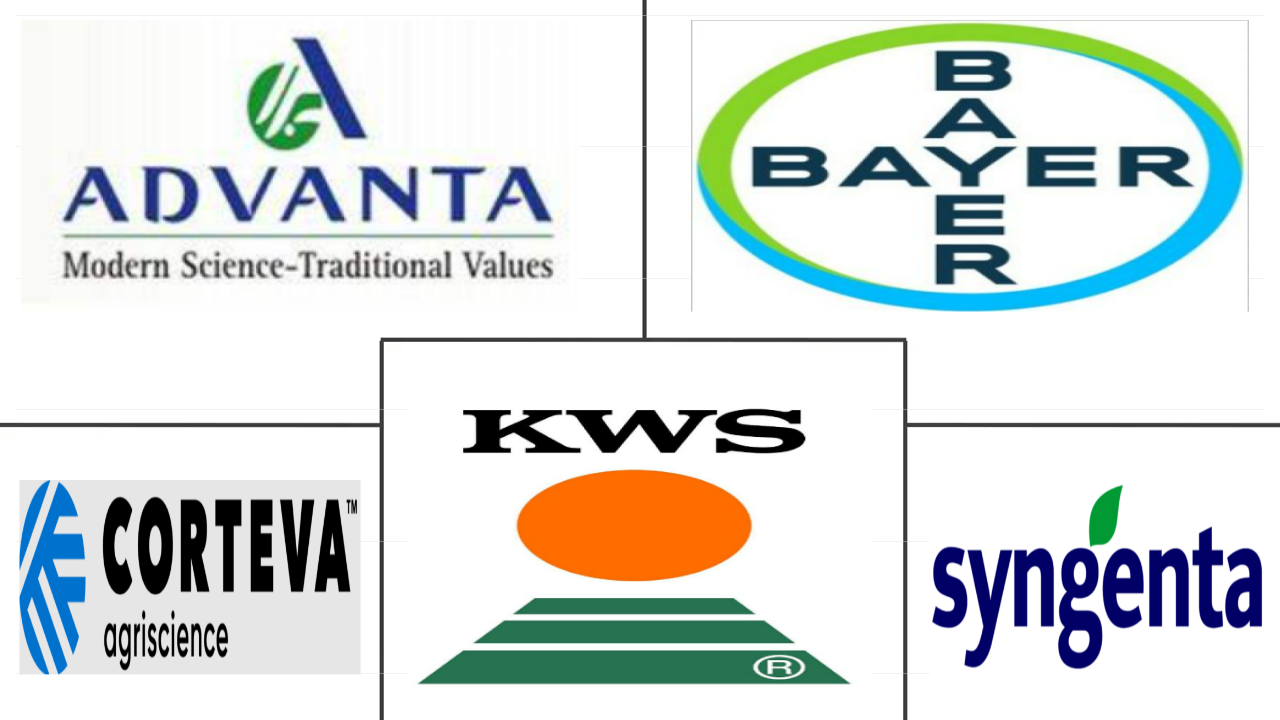Market Size of soybean seed Industry
| Icons | Lable | Value |
|---|---|---|
|
|
Study Period | 2017 - 2030 |
|
|
Market Size (2024) | USD 10.41 Billion |
|
|
Market Size (2030) | USD 15.05 Billion |
|
|
Largest Share by Breeding Technology | Hybrids |
|
|
CAGR (2024 - 2030) | 6.33 % |
|
|
Largest Share by Region | North America |
|
|
Market Concentration | Medium |
Major Players |
||

|
||
|
*Disclaimer: Major Players sorted in no particular order |
Soybean Seed Market Analysis
The Soybean Seed Market size is estimated at 10.41 billion USD in 2024, and is expected to reach 15.05 billion USD by 2030, growing at a CAGR of 6.33% during the forecast period (2024-2030).
10.41 Billion
Market Size in 2024 (USD)
15.05 Billion
Market Size in 2030 (USD)
8.81 %
CAGR (2017-2023)
6.33 %
CAGR (2024-2030)
Largest Market by Breeding Technology
87.10 %
value share, Hybrids, 2023
The major companies are developing new hybrids. The adoption of hybrids is high due to drought tolerance, disease resistance, high yield, and wider adaptability.
Largest Market by Country
38.28 %
value share, United States, 2023
It is the largest country due to the high demand for consumption, a leading producer of soybeans, an increase in the availability of improved seeds, and high profit margins. It is also a leading producer of soybeans.
Fastest-growing Market by Breeding Technology
6.58 %
Projected CAGR, Hybrids, 2024-2030
The fastest growth of hybrids is expected due to the increasing area under transgenic soybeans and the rise in the countries approved for transgenic (herbicide-tolerant) soybean cultivation.
Fastest-growing Market by Country
11.63 %
Projected CAGR, Germany, 2024-2030

Germany is the fastest-growing country because of the increase in demand by hotels for cooking oil and soybean meal and the lowering of the dependence on imports.
Leading Market Player
28.29 %
market share, Bayer AG, 2022

Bayer AG has the highest market share due to its broad product portfolio of soybeans, investments in research and development, and production of new and improved varieties.
Hybrids dominate the global soybean seed market due to their ability to resist biotic and abiotic factors and provide higher yields
- In 2022, hybrid seeds had a higher share than open-pollinated seed varieties because hybrid seeds are drought-resistant and have wider adaptability to different regions and weather conditions.
- In 2022, the non-transgenic hybrid soybean seed market had a share of about 20.4% of the hybrid soybean market by value. The growing awareness among people about the benefits of consuming non-GMO food is driving the growth of the non-transgenic seed segment. Additionally, transgenic soybean cultivation is banned in Europe, which is also a significant driver for this segment.
- In 2022, North America held the largest share in the hybrid segment. It accounted for 46.6% of the region's soybean seed market by value because of the increasing sowing area under transgenic seeds and the high seed replacement rate compared to other regions.
- In the transgenic segment, Asia-Pacific is expected to be one of the fastest-growing regions during the forecast period, with an estimated CAGR of 3.9%. Herbicide-tolerant hybrids accounted for a significant share of 98.1% of the region's soybean transgenic seed market by value in 2022, which is expected to increase as the Chinese government is providing an incentive to increase production using herbicide-tolerant seeds.
- Globally, open-pollinated seed varieties are used less than hybrid seed varieties because OPVs are not resistant to diseases and can be attacked easily by biotic and abiotic factors. Therefore, growers use hybrid seed traits with improved characteristics to minimize crop loss due to weeds and insects and increase yield.
- Therefore, the increasing effects of pests and diseases on crop losses and benefits such as higher yield and resistance to diseases are estimated to drive the hybrid seed segment at the fastest rate during the forecast period.
North America is the leading producer of soybeans, and the availability of new seed varieties, especially GM seeds, is driving the market
- North America is the leading producer of soybeans. The region accounted for 43.4% of the global soybean seed market in 2022. The United States is the leading producer of soybeans in the region, and there has been an overall increase in the cultivation area for soybeans in the region. For instance, the cultivation area in North America increased by 14.8% from 2019 to 2022 as growers preferred to cultivate soybeans compared to any other crop due to its high profits. These factors are anticipated to drive the region's soybean market at a CAGR of 6.6% during the forecast period.
- South America accounted for about 29.2% of the global soybean seed market in 2022, and it is projected to register a CAGR of 7.1% during the forecast period due to the increase in the adoption of hybrid seeds and cultivation areas and the availability of genetically modified crop seeds in South America. Moreover, the area under cultivation for soybeans in the region increased by 10.8% from 2017 to 2022 and 63.2 million hectares in 2022 due to the hybridization and approval of GM seeds in the two major countries of the region.
- Asia-Pacific accounted for about 19.3% of the market in 2022. China and India were the major soybean-producing countries in the region. Moreover, India was the leading producer of soybeans in the world, as it accounted for 2.7% in 2022, with a cultivation area of 12.3 million hectares in the same year. With growing demand for soybeans from various industries, the region's soybean market is anticipated to register a CAGR of 4.0% during the forecast period.
- The growing cultivation area of soybeans across different regions, the availability of new and improved seed varieties, and the growing demand for soybeans are anticipated to drive the market during the forecast period.
Soybean Seed Industry Segmentation
Hybrids, Open Pollinated Varieties & Hybrid Derivatives are covered as segments by Breeding Technology. Africa, Asia-Pacific, Europe, Middle East, North America, South America are covered as segments by Region.
- In 2022, hybrid seeds had a higher share than open-pollinated seed varieties because hybrid seeds are drought-resistant and have wider adaptability to different regions and weather conditions.
- In 2022, the non-transgenic hybrid soybean seed market had a share of about 20.4% of the hybrid soybean market by value. The growing awareness among people about the benefits of consuming non-GMO food is driving the growth of the non-transgenic seed segment. Additionally, transgenic soybean cultivation is banned in Europe, which is also a significant driver for this segment.
- In 2022, North America held the largest share in the hybrid segment. It accounted for 46.6% of the region's soybean seed market by value because of the increasing sowing area under transgenic seeds and the high seed replacement rate compared to other regions.
- In the transgenic segment, Asia-Pacific is expected to be one of the fastest-growing regions during the forecast period, with an estimated CAGR of 3.9%. Herbicide-tolerant hybrids accounted for a significant share of 98.1% of the region's soybean transgenic seed market by value in 2022, which is expected to increase as the Chinese government is providing an incentive to increase production using herbicide-tolerant seeds.
- Globally, open-pollinated seed varieties are used less than hybrid seed varieties because OPVs are not resistant to diseases and can be attacked easily by biotic and abiotic factors. Therefore, growers use hybrid seed traits with improved characteristics to minimize crop loss due to weeds and insects and increase yield.
- Therefore, the increasing effects of pests and diseases on crop losses and benefits such as higher yield and resistance to diseases are estimated to drive the hybrid seed segment at the fastest rate during the forecast period.
| Breeding Technology | ||||||||
| ||||||||
| Open Pollinated Varieties & Hybrid Derivatives |
| Region | |||||||||||||||||
| |||||||||||||||||
| |||||||||||||||||
| |||||||||||||||||
| |||||||||||||||||
| |||||||||||||||||
|
Soybean Seed Market Size Summary
The soybean seed market is experiencing significant growth, driven by the increasing demand for soybeans as a major oilseed crop globally. The market is characterized by a shift towards hybrid seeds, which offer advantages such as drought resistance and adaptability to various climatic conditions. This shift is largely due to the limitations of open-pollinated seed varieties, which are more susceptible to diseases and pests. The non-transgenic segment is gaining traction, particularly in regions like Europe where transgenic cultivation is banned, and in North America, where there is a high seed replacement rate. The Asia-Pacific region is also emerging as a fast-growing market for transgenic seeds, spurred by government incentives in countries like China to boost production using herbicide-tolerant varieties.
North America and South America are the leading regions in soybean seed production, with the United States and Brazil being the top producers. The expansion of soybean cultivation areas in these regions is fueled by the high profitability of soybeans compared to other crops and the availability of genetically modified seeds. In Asia-Pacific, countries like China and India are significant contributors to the market, with increasing demand from oilseed industries driving expansion. The market is moderately consolidated, with major players like Advanta Seeds - UPL, Bayer AG, Corteva Agriscience, KWS SAAT SE & Co. KGaA, and Syngenta Group leading the way in developing new seed varieties with improved traits. These developments, along with favorable government policies and industrial applications, are expected to sustain the market's growth trajectory in the coming years.
Soybean Seed Market Size - Table of Contents
-
1. MARKET SEGMENTATION (includes market size in Value in USD, Forecasts up to 2030 and analysis of growth prospects)
-
1.1 Breeding Technology
-
1.1.1 Hybrids
-
1.1.1.1 Non-Transgenic Hybrids
-
1.1.1.2 Transgenic Hybrids
-
1.1.1.2.1 Herbicide Tolerant Hybrids
-
1.1.1.2.2 Insect Resistant Hybrids
-
1.1.1.2.3 Other Traits
-
-
-
1.1.2 Open Pollinated Varieties & Hybrid Derivatives
-
-
1.2 Region
-
1.2.1 Africa
-
1.2.1.1 By Breeding Technology
-
1.2.1.2 By Country
-
1.2.1.2.1 Egypt
-
1.2.1.2.2 Ethiopia
-
1.2.1.2.3 Ghana
-
1.2.1.2.4 Kenya
-
1.2.1.2.5 Nigeria
-
1.2.1.2.6 South Africa
-
1.2.1.2.7 Tanzania
-
1.2.1.2.8 Rest of Africa
-
-
-
1.2.2 Asia-Pacific
-
1.2.2.1 By Breeding Technology
-
1.2.2.2 By Country
-
1.2.2.2.1 Australia
-
1.2.2.2.2 Bangladesh
-
1.2.2.2.3 China
-
1.2.2.2.4 India
-
1.2.2.2.5 Indonesia
-
1.2.2.2.6 Japan
-
1.2.2.2.7 Myanmar
-
1.2.2.2.8 Philippines
-
1.2.2.2.9 Thailand
-
1.2.2.2.10 Vietnam
-
1.2.2.2.11 Rest of Asia-Pacific
-
-
-
1.2.3 Europe
-
1.2.3.1 By Breeding Technology
-
1.2.3.2 By Country
-
1.2.3.2.1 France
-
1.2.3.2.2 Germany
-
1.2.3.2.3 Italy
-
1.2.3.2.4 Netherlands
-
1.2.3.2.5 Poland
-
1.2.3.2.6 Romania
-
1.2.3.2.7 Russia
-
1.2.3.2.8 Spain
-
1.2.3.2.9 Turkey
-
1.2.3.2.10 Ukraine
-
1.2.3.2.11 United Kingdom
-
1.2.3.2.12 Rest of Europe
-
-
-
1.2.4 Middle East
-
1.2.4.1 By Breeding Technology
-
1.2.4.2 By Country
-
1.2.4.2.1 Iran
-
1.2.4.2.2 Rest of Middle East
-
-
-
1.2.5 North America
-
1.2.5.1 By Breeding Technology
-
1.2.5.2 By Country
-
1.2.5.2.1 Canada
-
1.2.5.2.2 Mexico
-
1.2.5.2.3 United States
-
1.2.5.2.4 Rest of North America
-
-
-
1.2.6 South America
-
1.2.6.1 By Breeding Technology
-
1.2.6.2 By Country
-
1.2.6.2.1 Argentina
-
1.2.6.2.2 Brazil
-
1.2.6.2.3 Rest of South America
-
-
-
-
Soybean Seed Market Size FAQs
How big is the Global Soybean Seed Market?
The Global Soybean Seed Market size is expected to reach USD 10.41 billion in 2024 and grow at a CAGR of 6.33% to reach USD 15.05 billion by 2030.
What is the current Global Soybean Seed Market size?
In 2024, the Global Soybean Seed Market size is expected to reach USD 10.41 billion.

